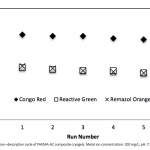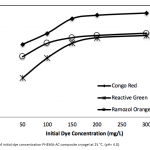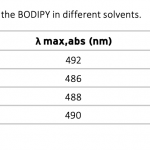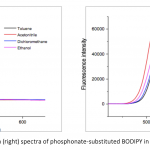| Title | Pages |
|---|---|
| Versatile Polymeric Cryogels and Their Biomedical Applications Cryogels are interconnected macroporous materials, which are synthesized under semi-frozen conditions. They can be either produced as pure polymeric or composite, that can find a variety of applications in several research field. The excellent features of composite cryogels such as, biocompatibility, physical resistance and sensitivity, making them extremely suitable for biomedical applications. They commonly take place in therapeutic, diagnostic and pharmaceutical applications in the field of biomedical research. This review focuses on the biomedical applications of composite cryogels, particularly in the field of tissue engineering, drug delivery systems and protein diagnosis. 



|
99 - 118 |
| Implications From A Microarray Analysis: Solute Carrier Proteins May Be Potential Targets to Combat Stemness of Breast Cancer Self renewal of cancer stem cells, intrinsic and/or acquired drug resistance are the main factors preventing the anti- cancer therapy strategies for breast cancer. There are progressing studies to develop new therapeutic agents and to investigate the biomarker molecules to be targeted. In this study, a cDNA microarray analysis was performed in anticancer drug-paclitaxel resistant breast cancer cell line, which expresses the properties of breast cancer stem cells (BCSC). The drug sensitive parental MCF-7 cell line was used as control group. The genes overexpressed in BCSC-like cells that encode solute carrier (SLC) proteins were analyzed. According to the results, 21 SLC protein encoding genes were upregulated in the range of 2.0 and 35 folds. The genes, SLC38A5, SLC43A3, SLC6A15, SLC1A1, SLC2A3, SLC26A2, SLC22A15 and SLC16A3 are overexpressed about 9-35 folds. So, the related proteins may be regarded as potential targets and this will open a new research venue for the discovery of biomarkers to target breast cancer stem cells. 

|
119 - 123 |
| Electrodeposition of Cadmium Sulfide and Lead (II) Sulfide onto Polycrystalline Gold Electrode Anew, simple and cost-effective electrochemical route was demontrated in this work. CdS and PbS thin films were grown on polycrystalline gold electrode using co-deposition and ECALE techniques based on accumulation layer by layer. The deposition potentials of cadmium, lead and sulfur were determined separately by cyclic voltammetry. Thin films were created from an electrolyte containing 0.01 molL-1 CdSO4, 0.01 molL-1 Na2S and 0.01 molL-1 Pb(CH3COO)2 in 0.01 molL-1 EDTA (pH = 3.00). The influence of bath temperature at the deposition potential was studied to determine the crystallinity of deposits. From the chronoamperometry results including the transients which were obtained within the under potential region, the overall shape of the experimental depositions was proposed and the growth process was considered. 



|
125 - 135 |
| Amoxicillin Loaded Magnetic Nanoparticles Developed For Treatment of Osteomyelitis Osteomyelitis is a bone infection caused by microorganisms. Localized efficient drug delivery for treatment osteomyelitis is an important topic. Amoxicillin is one of the antibiotics used for osteomyelitis therapy. Magnetic nanoparticles could achieve localized targeted treatment with the help of magnetic field. Starch is a biodegradable and biocompatible biopolymer and can be used for carrier material for drug delivery. The aim of this study is to develop amoxicillin loaded magnetic nanoparticles for the use of treatment of osteomyelitis. Here, magnetite nanostructures were coated with starch and characterized with FTIR, TGA and SEM. It was seen that nanoparticles were spherical and had a size of 14-36 nm. Amoxicillin loading onto magnetic nanoparticles was performed by adsorption method using various concentrations of drug and 0.483 mg amoxicillin was adsorbed on per mg of nanoparticles. In addition, in vitro drug release at pH 7.4 was obtained as in a controlled manner. As a conclusion, it can be suggested that amoxicillin loaded these nanoparticles could have a potential for drug delivery to osteomyelitis. 



|
137 - 145 |
| Optimization the Ultrasonic Assisted Extraction of Chlorogenic Acid from the Artichoke (Cynara Scolymus) Leaf with Response Surface Methodology and Total Phenolic Contents Artichoke leaf (Cynara Scolymus) extracts are widely used in medicine. Chlorogenic acids are the compounds which have antioxidant, antibacterial and antiviral properties. In this study, after the artichoke (Cynara scolymus) leaves were dried, the powdered portions were extracted with water. Extracts were analyzed by HPLC and the results were expressed as ppm. The optimum conditions for extracting chlorogenic acid from Cynara Scolymus were determined by ultrasonic assisted extraction using the Surface Response Method based on Box-Behnken design. The experimental conditions of extraction were determined as extraction time (15-45 minutes), temperature (30-70°C) and ultrasonic power (25-75%). The optimum conditions were determined as 47.65% ultrasonic power, 35.18 minutes, 53.40°C temperature. The maximum yield of chlorogenic acid was determined as 10.05 ppm. Also the total phenolic content was measured by UV -Vis spectrometry in order to see antioxidant activity. Absorbance values of the samples which were taken from each samples were measured at 765 nm in UV spectrometer. Optimum conditions were determined as 47.29% ultrasonic power, 29.67 minutes, 55.33% ethanol concentration. Total phenolic content were determined as 70.24 ppm. According to the obtained results, ultrasonic-assisted extraction (UAE) can be an effective method for the extraction of chlorogenic acid active ingredient. 



|
147 - 157 |
| A Polymeric Adsorbent for Removal And Recovery of Nickel From Aqueous Media The Interpenetrating Polymer Network (IPN) structure was obtained by gamma radiation of solution of polyethylene glycol (PEG) (35000MW) in an acrylonitrile (AN) to 14 and 60kGy doses were amidoximated with hydroxylamine solution at optimum amidoximation conditions. Effects of pH (2-10) and mNi/mIPN ratio (0.002-0.5) in Ni2+ adsorption were examined by batch process and optimum values were determined as 8 and 0.4 for both doses, respectively. Also, the effect of flow rate to Ni2+ adsorption was examined by the reflux flow process with a fixed-bed reactor at room temperature. Optimum flow rate is determined as 6 mL/s at optimum pH. Ni2+ adsorption studies were carried out in batch (pH= 6 and 8) and flow (pH= 8) systems. Maximum adsorption values reached for irradiated to 14 and 60kGy doses and amidoximated IPNs were given as 105 and 99 mgNi/gIPN in batch system (pH=6), 378 and 361 mgNi/gIPN in batch system (pH= 8) and 891 and 673mgNi/gIPN in flow system (pH= 8), respectively. Maximum elution efficiency was obtained for HCl as being 99.5% and 66.1% for IPNs irradiated to 14 and 60kGy doses and amidoximated, respectively. FTIR results showed that HCl caused structural deformation. Minimum elution efficiency was obtained for (NH4)2CO3 as being 60.1% and 58.2% for IPNs irradiated to 14 and 60kGy, respectively, by the minimum deformation. 



|
159 - 169 |
| Removal of Dyes from Aqueous Solution Using Activated Carbon Embedded Cryogels In this study poly(hydroxyethyl methacrylate) (PHEMA) based activated carbon (AC) embedded cryogel discs were synthesized, characterized and their application for dye removal from aqueous solutions were investigated. The effect of pH and initial dye concentration on the adsorption capacity of the cryogels were studied in a batch system. Desorption of dyes was also studied and it was shown that synthesized composite system could be repeatedly used without significant loss in the adsorption capacity after five repetitive adsorption–desorption processes. 



|
171 - 177 |
| Lectin Affinity Based Recognition Nanomaterial for Glucose Glucose is an important biomolecule because it is an important source of energy for cells and is used as an intermediate/ metabolic agent. Selective recognition of glucose is important for diagnosing many metabolic diseases. In this study, lectin ligand (Con A) attached p(GMA) nanopolymer was synthesized and characterized. The best interaction of p(GMA)-ConA nanopolymer and glucose was determined to be 10 mM glucose concentration at pH = 8.0. In the selectivity assay, p(GMA)-Con A was found to be 2-fold selective for glucose than galactose. Lectin affinity based nanopolymeric system that is selective, with high surface area, low cost and highly biocompatible with high adsorption capacity has been developed for recognition of glucose. 



|
179 - 190 |
| Camera-trap records of breeding Eurasian lynx (Lynx lynx) at the Mount Ilgaz Wildlife Reserve Breeding seasons are one of the most important periods for the life cycle of large mammals. The young individuals of large carnivore mammals are usually dependent on the female for food and protection. Therefore, availability of the sources and human disturbance at the breeding site are critical for a successful breeding season. The breeding site is of vital importance to the survival of the new-borns and thus to the trends in the population size. The present study assesses the breeding records of the Eurasian lynx (Lynx lynx) based on camera-trapping surveys at the Mount Ilgaz Wildlife Reserve in the province of Kastamonu. The surveys were conducted continuously over a four year period (2014-2018) and the results indicate that the camera-trap stations, which detected the cubs of Eurasian lynx, have also been used by the juvenile individuals of two other top predator large mammals, brown bear (Ursus arctos) and grey wolf (Canis lupus) and the juveniles of their prey species, red deer (Cervus elaphus) and brown hare (Lepus europaeus). Consequently, further assessment of the Wildlife Reserve Area considering the breeding records of the large mammals will contribute to have more effective protection for the Eurasian lynx and other wildlife populations in the Western Black Sea Region of Anatolia. 



|
191 - 196 |
| The Design, Synthesis and Spectroscopic/Photophysical Characterization of Phosphonate-substituted BODIPY BODIPY compounds continue to attract the attention of scientists from multidisciplinary areas because of the wide range applications and excellent photophysical properties as fluorescent sensors or dyes. In this study, a new phosphonate-substituted BODIPY dye was synthesized by classical condensation-oxidation-complexation method from pyrrolic compounds and aldehyde. The structure and photophysical properties of the synthesized BODIPY compound were determined by 1H NMR, 13C NMR, 31P NMR, 19F NMR, UV-Vis absorption and fluorescence spectroscopic techniques. 



|
197 - 201 |